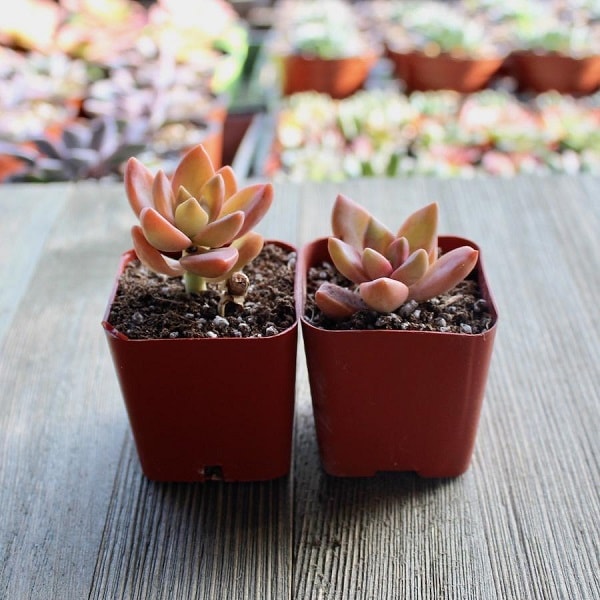This time I want to talk about the Graptosedum or commonly known California Sunset Succulent.
It is an easy plant to grow, I highly recommend it to everyone who wants to start growing succulent as it has basic care.
Some of its characteristics are that it has a long growth which is is ideal for putting in place high.
Its beautiful colors brown yellow red a whole mixture of this colors, which could vary depending on how she is exposed to the sun.
It is a heavy bloomer, yellow flowers are numerous and produce more easily than in many other species.
Like many succulent plants, the colors change in the seasons.
The california Sunset Succulent is very good for times of drought.
As it grows, it loses its leaves but this is part of the process.
The California sunset succulent is a hybrid cross between Graptopetalum paraguayense and Sedum Adolphi, the plant is classified as a Graptosedum.
Tips to take care of the california sunset succulent
Habit
It is a rosette of formation, succulent plant without hair.
The rosettes grow at the ends of increasingly long hanging stems creating a low spreading colony at only about 15 cm tall.
Stems
5-8 mm wide 10-12 cm in diameter, with sheets of tiles that form a symmetrical Fibonacci spiral.
Old leaves at the base of the cross rosette and fall off.
The new growth is from the center of the rosette, over time a stem is obtained with a rosette at the end.
Leaves
Succulent, lanceolate up to 6.7 cm long light green glaucous.
Those grown in partial shade tend to be blue-gray in color; in its entirety, the hot pinkish pink sun.
During the winter, the leaves take a brown-purple tint enhanced by the low temperature.
Flowers
Star-shaped. 5 yellow petals, c.2 cm in diameter, supported on the stems 15 cm long with 2-6 branches, each with 3-14 flowers.
Petals c. 1 cm long white, dotted with red.
Blooming season
The plant blooms profusely in late spring-early winter.
Cultivation and propagation
Graptosedum cv culture ‘Francesco Baldi’ is quite easy, you can tolerate full sun (where it stays compact) but better exposure is mid-sun.
The origin of the plant will make its rosettes tolerate heat, frost, and drought.
He is always a favorite carefree windowsill citizen, an excellent addition to any garden
It is propagated by stem division or by individual leaves, rooted in sand or dried vermiculite.
Any rosette that emerges has the potential to finish and start a new plant.
Even a falling leaf will take root below the mother plant and produce a new rosette quickly.
Because the leaves and root cuts effortlessly, graptopetalums are some of the easiest succulents to propagate.
Exposure
Likes a light shade from the sun (which will take a couple of hours of sun without a problem), but it adapts very well to full sun and shade as well.
You can winter so they also grow under the lights in a cool room in the house.
Graptosedums are chameleons.
Those grown in partial shade tend to be blue-gray in color; in its entirety, the hot sun, pink-gray; in full sun, pink gray to yellow.
Soil
Although you need a soil that is sandy and porous with good drainage, the soil must be able to maintain the moisture that the plant requires.
The ideal soil should contain equal parts of clay with small gravel added (for example, pumice or lava sand). Good drainage is essential.
Watering
During the summer growth period the plant seems to need much more water than the succulent average.
Water when the plant is dry and do not water again until the soil is completely dry again.
He doesn’t like excess watering.
Pay special attention to ensure that they do not rot at the root of the soaked soil.
During October to March, water in moderation, only with enough water to maintain wilting foliage.
In a very humid situation in winter, it can rot although completely dry. He likes dry air as much as dry soil.
Fertilization
The fertilizer should be applied only once in early spring, diluted to ¼ of the dose recommended on the label.
Climate
It is generally recommended to avoid temperatures below zero, but it is a very resistant succulent and can recover from being frozen and is useful in areas that fall below -5 ° (-7 °) C.
It requires low temperature for formation of flowers and will not bloom unless it has been hibernated for at least a month at 15 ° C or less. USDA zones 9-11.
Pests and diseases
There are no serious problems with insects or diseases.
Watch for aphids and scale. Mealybugs infestations are also a frequent problem.
Human dangers
None
Uses
A large plant for use as a vegetation cover, in gravel gardens, paved areas, rock gardens, in hanging baskets or pots, or spilling onto the walls.
It is a bit fragile so avoid handling when possible and not for planting in areas with heavy traffic.
Because the stems are so fragile, it is best to choose the best location for the ghost plant and then don’t move it.
Try mixing with other succulents and alpine plants.
Conclusion
Find a spot where this plant gets the appropriate amount of sun.
That would ideally be a morning sunspot.
If you’re acclimating the plant to full sun for the first time, start with an hour or two, depending on the season and the intensity of the light where you are.
The California Sunset succulent has minimal fertilization needs.
When it is growing in proper soil and sunlight, and in the right container, you’ll see growth and development during its growing season.
Do all this and you will be fine.
